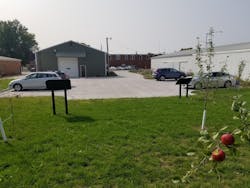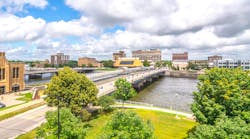Katie Johns is managing editor of Storm Water Solutions. Johns can be reached at [email protected].
undefinedDilapidated. An eyesore.
Those are just a couple adjectives that come to mind when Paul Berland talks about the former Northeast Iowa Resource Conservation and Development parking lot.
The lot is in a prominent location – a high traffic corner in downtown Postville, Iowa.
But when the city secured funding for water quality improvements in the community through the state revolving fund, multiple locations were identified for upgrades, including the Northeast Iowa RC&D site.
The other locations included general street drainage areas and an existing crushed stone parking lot at a YMCA facility that dealt with a fair amount of runoff during rainfall events.
Through the project, the town was able to add enhanced rain gardens near the downtown area and another in a residential park area. Additionally, permeable pavers were used to restore the YMCA parking lot, which has 20 to 25 spaces.
While the YMCA project was more of a maintenance project, the other sites highlight the tax that storm water sewer systems take on over time – specifically, the major project at the Northeast Iowa Resource Conservation and Development site.
The Northeast Iowa RC&D site, which is about three-quarter acres, now serves as a demonstration site showcasing best management practices. But prior to that, the site, which used to be a lumberyard, was pretty run down.
“You can kind of envision what that was – just crushed stone all over everywhere, and it didn’t drain well,” said Jon Biederman, senior project manager with Fehr Graham, who worked with the city on these projects. “They had some drainage issues. The water would get into the building and kind of just pool around on site. They had a parking lot and drive to get to the back of the office building [in the] middle of the site that was rough, didn’t drain well.”
Berland, executive director of the Northeast Iowa RC&D, compares the runoff issues after rain to having a lake in the parking lot. The transformation has helped to set an example for the partners they work with.
“We do a lot of work with partners on flood reduction projects throughout the Northeast Iowa Watershed wide, so for us to be able to sort of put our money where our mouth is and make this project a demonstration site and do our part as an organization on the land that we control was really exciting for us,” Berland said.
And as of today, there is zero runoff from the Northeast Iowa RC&D site. Biederman said everything is infiltrated and treated through practices, such as permeable pavers, rain gardens, an infiltration trench and a couple bioswales. The permeable pavers were used to construct the driveway and parking area, along with a patio that can be used as an outdoor classroom. Additionally, upstream of the site, the team amended the soil and planted apple trees in an orchard snf native plantings.
Additionally, the Northeast Iowa RC&D developed interpretive panels for the site that are multi-lingual and explain the different practices and why urban storm water management is so important – both from a flooding standpoint and a water quality perspective.
With the site restoration, the goal was not only to improve water quality, but to make it into the demonstration site it is today. Berland said the Northeast Iowa RC&D has partnered with the EPA through a grant to host school groups and community leaders to provide tours and explain the various practices. They have also created curriculum that educators can bring back to use in their classrooms.
“If everybody is interested about these various practices, like permeable pavers, bioretention, soil amendment, native plantings, all of that, but it’s like well where do you go to see those?” Biederman said. “We were able to fit all of that and more on to this three-quarter acre — plus or minus — site to where if a community, a school, a municipality, whatever, anybody really wants to come and see all these practices in one location, they can do that. None of them are huge, but at the same time, they’re all there.”
Due to the COVID-19 pandemic, touring was limited in 2020, but the center got creative and produced videos explaining the practices, like they would have if a tour had been in-person. Now, though, the center is gearing up to offer more tours.
“Most of the water that feeds from our end of town feeds into a trout stream,” Berland said. “And so, we really want to make sure that we’re doing our part to protect that, and I think providing that education to everybody is a crucial piece moving forward to sort of help us become more resilient, develop a more resilient landscape.”
The project did not encounter any unexpected challenges. To accommodate the clay-based soils in the area, the project team used a thicker stone base to give the pavers as much of a chance to infiltrate. Additionally, the parking lot was far from flat, Biederman said, so the team constructed impermeable baffles along the slope to hold the water back as it went through the paver system, rather than having it running to the bottom.
“The installation of all the practices is complete,” Berland said. “The interpretative components are there, and we’ve had multiple heavy rainfalls since installation, and like I said, you can’t find a puddle on our property. It’s all being handled through the practices, and it’s dramatically improved.”
For its green infrastructure practices within the community and the efforts at the Northeast Iowa RC&D demonstration site, this project earned Postville the 2021 Stormwater and Urban Watershed Partner of the Year award from the Iowa Stormwater Education Partnership.






